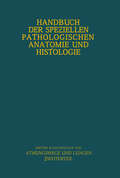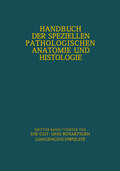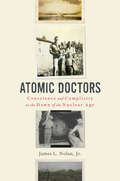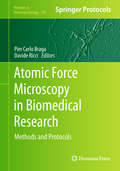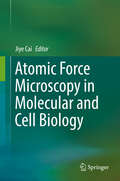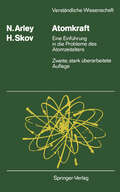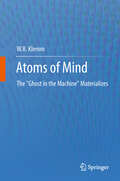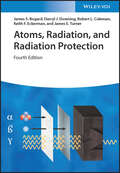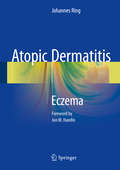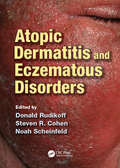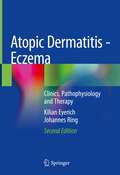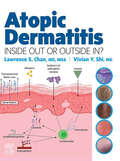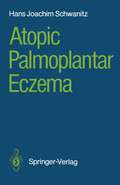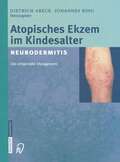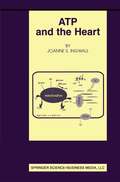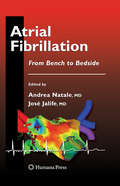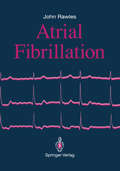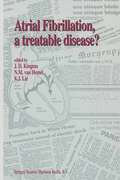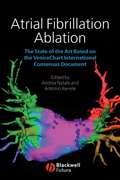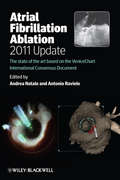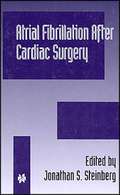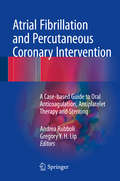- Table View
- List View
Atmungswege und Lungen (Handbuch der speziellen pathologischen Anatomie und Histologie #3 / 2)
by W. Berblinger W. Ceelen F. Danisch W. Fischer C. Hart F. Henke W. Koch A. Lauche H. Loeschcke O. Lubarsch E. Mayer H. Müller W. Pagel K. Plenge H. G. Runge M. Schmidtmann M. VerséDieser Buchtitel ist Teil des Digitalisierungsprojekts Springer Book Archives mit Publikationen, die seit den Anfängen des Verlags von 1842 erschienen sind. Der Verlag stellt mit diesem Archiv Quellen für die historische wie auch die disziplingeschichtliche Forschung zur Verfügung, die jeweils im historischen Kontext betrachtet werden müssen. Dieser Titel erschien in der Zeit vor 1945 und wird daher in seiner zeittypischen politisch-ideologischen Ausrichtung vom Verlag nicht beworben.
Atmungswege und Lungen: Vierter Teil Die Gut- und Bösartigen Lungengeschwülste (Handbuch der speziellen pathologischen Anatomie und Histologie #3 / 4)
by Hermann Eck R. Haupt G. RotheAtomic Doctors: Conscience And Complicity At The Dawn Of The Nuclear Age
by James L. NolanAn unflinching examination of the moral and professional dilemmas faced by physicians who took part in the Manhattan Project.After his father died, James L. Nolan, Jr., took possession of a box of private family materials. To his surprise, the small secret archive contained a treasure trove of information about his grandfather’s role as a doctor in the Manhattan Project. Dr. Nolan, it turned out, had been a significant figure. A talented ob-gyn radiologist, he cared for the scientists on the project, organized safety and evacuation plans for the Trinity test at Alamogordo, escorted the “Little Boy” bomb from Los Alamos to the Pacific Islands, and was one of the first Americans to enter the irradiated ruins of Hiroshima and Nagasaki.Participation on the project challenged Dr. Nolan’s instincts as a healer. He and his medical colleagues were often conflicted, torn between their duty and desire to win the war and their oaths to protect life. Atomic Doctors follows these physicians as they sought to maximize the health and safety of those exposed to nuclear radiation, all the while serving leaders determined to minimize delays and maintain secrecy. Called upon both to guard against the harmful effects of radiation and to downplay its hazards, doctors struggled with the ethics of ending the deadliest of all wars using the most lethal of all weapons. Their work became a very human drama of ideals, co-optation, and complicity.A vital and vivid account of a largely unknown chapter in atomic history, Atomic Doctors is a profound meditation on the moral dilemmas that ordinary people face in extraordinary times.
Atomic Force Microscopy in Biomedical Research: Methods and Protocols (Methods in Molecular Biology #736)
by Pier Carlo Braga and Davide RicciWith its ability to explore the surface of the sample by means of a local scanning probe and its use of dedicated software allows to be visualize results, atomic force microscopy (AFM) has revolutionized the study of the smallest aspects of life. Atomic Force Microscopy in Biomedical Research: Methods and Protocols proves that this technology is no longer simply just another form of microscopy but has given rise to a completely new way of using microscopy that fulfils the dreams of all microscopists: being able to touch, move, and interact with the sample while it is being examined, thus making it possible to discover not only morphological but also chemical and physical structural information. Covering such topics as molecule imaging, nanoscale surface analysis and cellular imaging, force-spectroscopy, investigating drug action, and AFM as a nanotool, this volume features the most up-to-date techniques currently in use. Written in the Methods in Molecular Biology™ series format, chapters include introductions to their respective topics, lists of the necessary materials, step-by-step, readily reproducible protocols, and expert tips on troubleshooting and avoiding known pitfalls. Comprehensive and cutting-edge, Atomic Force Microscopy in Biomedical Research: Methods and Protocols brings together different types of applications in order to provide examples from diverse fields in the hope of inspiring researchers to apply their ingenuity in their own specialization and add significant originality to their varying studies.
Atomic Force Microscopy in Molecular and Cell Biology
by Jiye CaiThe book addresses new achievements in AFM instruments – e.g. higher speed and higher resolution – and how AFM is being combined with other new methods like NSOM, STED, STORM, PALM, and Raman. This book explores the latest advances in atomic force microscopy and related techniques in molecular and cell biology. Atomic force microscopy (AFM) can be used to detect the superstructures of the cell membrane, cell morphology, cell skeletons and their mechanical properties. Opening up new fields of in-situ dynamic study for living cells, enzymatic reactions, fibril growth and biomedical research, these combined techniques will yield valuable new insights into molecule and cell biology. This book offers a valuable resource for students and researchers in the fields of biochemistry, cell research and chemistry etc.
Atomkraft: Eine Einführung in die Probleme des Atomzeitalters (Verständliche Wissenschaft #73)
by Niels Arley Helge SkovDem nach der Tschernobyl-Katastrophe stark angewachsenen Informationsbedürfnis über die Möglichkeiten und Risiken der Kernkraft-Ausnutzung trägt diese Neuauflage Rechnung. In verständlicher Form wird in die technischen, militärischen, medizinischen und biologischen Probleme des Atomzeitalters eingeführt. Besondere Beachtung findet dabei das Dilemma der modernen Technik, häufig mit der Lösung alter Probleme neue zu kreieren.
Atoms of Mind: The "Ghost in the Machine" Materializes
by W.R. KlemmThis book describes the author’s view of how the mind “thinks” at various levels of operation. These levels include nonconscious mind (as in spinal/brainstem reflexes and neuroendocrine controls), subconscious mind, and conscious mind. In the attempt to explain conscious mind, there is considerable critique of arguments over whether or not free will is an illusion. Finally, the author summarizes current leading theories for consciousness (Bayesian probability, chaos, and quantum mechanics) and then presents his own theory based on patterns of nerve impulses in circuits that are interlaced coherently into larger networks.
Atoms, Radiation, and Radiation Protection
by James S. Bogard Darryl J. Downing Robert L. Coleman Keith F. Eckerman James E. TurnerAtoms, Radiation, and Radiation Protection Discover the keys to radiation protection in the fourth edition of this best-selling textbook A variety of atomic and sub-atomic processes, including alpha, beta, and gamma decay or electron ejection from inner atom shells, can produce ionizing radiation. This radiation can in turn produce environmental and biological effects both harmful – including DNA damage and other impacts of so-called ‘radiation sickness’ – and helpful, including radiation treatment for cancerous tumors. Understanding the processes that generate radiation and the steps which can be taken to mitigate or direct its effects is therefore critical in a wide range of industries and medical subfields. For decades, Atoms, Radiation, and Radiation Protection has served as the classic reference work on the subject of ionizing radiation and its safeguards. Beginning with a presentation of fundamental atomic structure and the physical mechanisms which produce radiation, the book also includes thorough discussion of how radiation can be detected and measured, as well as guide-lines for interpreting radiation statistics and detailed analysis of protective measures, both individual and environmental. Now updated by a new generation of leading scholars and researchers, Atoms, Radiation, and Radiation Protection will continue to serve global scientific and industrial research communities. Readers of the fourth edition of Atoms, Radiation, and Radiation Protection will also find: Detailed updates of existing material, including the latest recommendations of the ICRP and NCRP Treatment of current physiokinetic and dosimetric models All statistics now presented in SI units, making the book more globally accessible Atoms, Radiation, and Radiation Protection is a foundational guide for graduate students and researchers in health physics and nuclear physics, as well as related industries.
Atoms, Radiation, and Radiation Protection
by James S. Bogard Darryl J. Downing Robert L. Coleman Keith F. Eckerman James E. TurnerAtoms, Radiation, and Radiation Protection Discover the keys to radiation protection in the fourth edition of this best-selling textbook A variety of atomic and sub-atomic processes, including alpha, beta, and gamma decay or electron ejection from inner atom shells, can produce ionizing radiation. This radiation can in turn produce environmental and biological effects both harmful – including DNA damage and other impacts of so-called ‘radiation sickness’ – and helpful, including radiation treatment for cancerous tumors. Understanding the processes that generate radiation and the steps which can be taken to mitigate or direct its effects is therefore critical in a wide range of industries and medical subfields. For decades, Atoms, Radiation, and Radiation Protection has served as the classic reference work on the subject of ionizing radiation and its safeguards. Beginning with a presentation of fundamental atomic structure and the physical mechanisms which produce radiation, the book also includes thorough discussion of how radiation can be detected and measured, as well as guide-lines for interpreting radiation statistics and detailed analysis of protective measures, both individual and environmental. Now updated by a new generation of leading scholars and researchers, Atoms, Radiation, and Radiation Protection will continue to serve global scientific and industrial research communities. Readers of the fourth edition of Atoms, Radiation, and Radiation Protection will also find: Detailed updates of existing material, including the latest recommendations of the ICRP and NCRP Treatment of current physiokinetic and dosimetric models All statistics now presented in SI units, making the book more globally accessible Atoms, Radiation, and Radiation Protection is a foundational guide for graduate students and researchers in health physics and nuclear physics, as well as related industries.
Atopic Dermatitis: Eczema
by Johannes RingThis book presents the state of the art in research into atopic dermatitis, or atopic eczema, and provides numerous effective practical management recommendations that are grounded in the immense clinical experience of the author. A scientific evidence-based approach to the subject is adopted, progressing from clinical symptoms in different disease stages, molecular genetics, and pathophysiology through to treatment and prevention. All aspects of patient management are covered, including diagnostics, avoidance strategies, emollient therapy, and acute treatment of eczema and itch. Diverse special therapeutic approaches are discussed, ranging from glucocorticoids, topical calcineurin inhibitors, and antimicrobial therapy through to UV therapy, allergen-specific immunotherapy, systemic immunosuppressive therapy, and emerging options. Environmental influences are considered, and there is a focus on the whole human being, with attention to psychosocial aspects of the disease and the benefit of educational programs such as “eczema schools”. Atopic Dermatitis will be invaluable for dermatologists, allergists, pediatricians, and general practitioners and informative for other interested persons and sufferers.
Atopic Dermatitis and Eczematous Disorders
by Donald Rudikoff Steven Cohen Noah ScheinfeldIt is estimated that around 15% of the population suffer from atopic dermatitis or eczematous disorders at some point in their lifetime, causing a significant percentage of visits to dermatologists, primary care physicians, and allergists. Despite much current research interest, the pathophysiology of these disorders and their optimum treatment rem
Atopic Dermatitis and Eczematous Disorders
It is estimated that around 15% of the population suffer from atopic dermatitis or eczematous disorders at some point in their lifetime, causing a significant percentage of visits to dermatologists, primary care physicians, and allergists. Despite much current research interest, the pathophysiology of these disorders and their optimum treatment rem
Atopic Dermatitis - Eczema: Clinics, Pathophysiology and Therapy
by Kilian Eyerich Johannes RingThis entirely revised edition of the successful work presents the state of the art in clinics, research and practical management of atopic dermatitis - eczema. The wide variability in clinical morphology including differences between age groups and ethnicities is illustrated by color pictures including the typical minimal manifestations or “stigmata” suggestive of atopy. The dramatic rise in the prevalence of this disease over the last few decades is reflected by detailed analyses of epidemiological data from all over the world. In-depth descriptions of key pathophysiological mechanisms including epidermal barrier, molecular genetics, itch pathophysiology and modern cellular immunology offer readers a deeper understanding of the complex events leading to the often excruciating symptoms. Treatment – and management – comprises all aspects from elicitor avoidance to basic emollient skin care, immuno-modulating treatments both topical and systemic, up to the latest advances in kinase inhibitors and biologics.In turn, the book discusses the role of the microbiome and antimicrobial treatments as well as phototherapy, provides dietary recommendations for individuals with food allergies, and explores psychosocial aspects of the disease. Environmental influences are considered with regard to irritants and allergens. All recommendations are based on current national and international guidelines. The complex management strategies for this disease have led to the emergence of educational programs (Eczema Schools), which the authors have developed and promoted at the national and international level. This new revised edition of Atopic Dermatitis - Eczema will be an invaluable asset for dermatologists, allergists, pediatricians and general practitioners, but also for all related health personnel and patient organizations interested in gaining a fuller understanding of this widespread skin disease.
Atopic Dermatitis: Inside Out or Outside In - E-Book
by Lawrence S. Chan, MD, MHA, FAAD Vivian Y. Shi, MD, FAADAtopic dermatitis (eczema) is one of the most common and most challenging skin conditions, for patients and practitioners alike. Uniquely organized by intrinsic and extrinsic etiologies, Atopic Dermatitis: Inside Out or Outside In? examines a myriad of causes that start from both the inside of the body and from the external environment, offering physicians practical ways to design treatments that specifically address these causes. Drs. Lawrence S. Chan and Vivian Y. Shi, along with a team of expert contributing authors, examine the etiology of this complex disorder and provide targeted, comprehensive solutions and the most useful therapeutic plans based on pathophysiology, including evidence-based integrative management. Analyzes the pathophysiology of atopic dermatitis from two distinct fronts: inside out and outside in—an approach that is unique in the field. Begins with an overview of the disease, then delves into both internal and external pathogenic factors, followed by the Clinician’s Corner, which offers practical recommendations for treatment. Organizes therapeutic discussions by corresponding pathophysiology rather than a one-size-fits-all approach. Covers recently FDA-approved and emerging medications, as well as atopic comorbidities.
Atopic Palmoplantar Eczema
by Hans Joachim SchwanitzThe field of dermatology has very much changed during the last decades. An ever-increasing knowledge about the pathogenesis of diseases of the skin has made it possible to not only better classify but also to make dermatoses better explainable and understandable. The present book exemplifies this with a very common disease, the dyshidrotic eczema of the hands. Most current textbooks still describe "dyshidrosis" as a disease of the eccrine sweat glands, as was first postulated in 1873 by T. Fox. In 1962, R. D. G. P. Simons challenged this concept and since then, it has not been possible to establish a uniform pathogenetic concept regarding "dyshidrosis". The only generally accepted view is that the dermatosis has multiple etiologies. This monograph is intended to be a follow-up to Simons' book published in 1966, entitled Eczema of the Hands. Investigations into Dyshidrosiform Eruptions. It repre sents an attempt to view the clinical and experimental aspects of atopic palmoplantar eczema as a basis for an understanding of the entire entity of dyshidrosis. My special thanks go to Prof. Dr. E. Macher, Miinster, who made it possible for me to complete this work, to Prof. Dr. S. Nolting, Miinster, who aroused my interest in the subject, and to Prof. Dr. P. Frosch, Heidelberg, who generously provided the necessary technical equipment for investiga tional use. Clinical examinations are impossible without patients and control per sons. I would like to thank all the people who took part in this project.
Atopisches Ekzem im Kindesalter (Neurodermitis): Zeitgemäßes Management
by D. Abeck J. RingInterdisziplin?er Praxis-Leitfaden zu allen Fragen der Differenzialdiagnose, Therapie und Pr?ention. Mit anschaulichen Farbabbildungen, Patientenfragebogen und wichtigen Adressen.
ATP and the Heart (Basic Science for the Cardiologist #11)
by Joanne S. IngwallATP plays a central role in the two leading causes of cardiac morbidity and mortality in the western world: ischemia and heart failure. We are in our infancy applying what is known about biology and chemistry of ATP toward developing effective therapies for these diseases. In this volume, the current understanding of the chemistry and biology of ATP specifically in the cardiomyocyte is presented. New insights into ATP have been gleaned using biophysical techniques allowing dynamic measurement of chemical events in the intact beating heart and using new animal models in which cardiac proteins are either over expressed, deleted or harbor specific mutations. This book provides a summary of the basic understanding and includes illustrations of why ATP and the Heart is important to both the clinician and scientist.
Atrial Fibrillation: From Bench to Bedside (Contemporary Cardiology #Volume 92-1)
by Andrea Natale José JalifeThis important new book presents advancements in the treatment and prevention of Atrial Fibrillation (AF). The reader is provided with the latest information that is critically important in the daily care and for the potential cure of patients with AF. Each chapter deals with a different aspect of AF and each chapter is authored by internationally recognized experts in the evolving field of cardiac electrophysiology. This book is a single source that provides a multi-perspective look at and approach to AF. Because AF is so prevalent and affects all areas of medicine, the information in this book will be useful to all those in the medical field.
Atrial Fibrillation, a Treatable Disease? (Developments in Cardiovascular Medicine #139)
by K. I. Lie N. M. Hemel J. H. KingmaThe attack of atrial fibrillation experienced by President Bush of the United States attracted more attention from the general public to atrial fibrillation than ever before. Also, there is a growing body of knowledge of the pathophysiologic mechanism, the pathology and epidemiology, and especially of the thrombo-embolic complications of this arrhythmia, which is responsible for a renewed interest of the clinician in this very common human arrhythmia. These new perspectives on atrial fibrillation were presented during a conference on `Atrial Fibrillation, a Treatable Disease?', organized on May 7, 1992, in Amsterdam, the Netherlands. Atrial fibrillation is not the prerogative of the cardiologist only. Many practitioners from other areas in health care, in particular general physicians, internists and neurologists, are faced with this arrhythmia and its untoward consequences. This book bridges the gap between theory, experiment and the clinic. Emphasis is therefore on the selection of the optimal approach, including pharmacotherapy, catheter ablation, pacemaker and surgical therapy, based on the current scientific insights in the mechanism and prevention of atrial fibrillation.
Atrial Fibrillation Ablation: The State of the Art based on the Venicechart International Consensus Document
by Andrea Natale Antonio RavieleIn recent years, catheter ablation of atrial fibrillation has become a widespread treatment modality in electrophysiology laboratories all over the world. Nevertheless, many aspects of the therapy are controversial. Developed by world-renowned experts in the field, this book presents a comprehensive and up-to date overview of all the most important and debated aspects of atrial fibrillation ablation, including: • Ablation techniques and technologies • Procedural endpoints • Patient management pre-, peri- and post-ablation • Anticoagulation issues • Prevention and treatment of complications • Definition of success and long-term results The text expands upon the content of the VeniceChart international consensus document on atrial fibrillation ablation and is enriched by several explanatory figures and tables. It provides a highly valuable source of information not only for researchers and specialists in electrophysiology, but also for general cardiologists, internists, fellows in cardiology and medical students.
Atrial Fibrillation Ablation, 2011 Update: The State of the Art based on the VeniceChart International Consensus Document
by Andrea Natale Antonio RavieleThis concise text presents best practices for all aspects of atrial fibrillation ablation as outlined in the new version of the VeniceChart International Consensus document, which is presented in conjunction with the biannual Venice Arrhythmias conference. In addition to discussing the latest in a-fib ablation research, this 2011 update covers all the key areas of therapy and patient management, including: • Techniques and technologies • Procedural endpoints • Patient management pre-, peri- and post-ablation • Prevention and treatment of complications • Definition of success and long-term results With contributions from the world’s recognized thought leaders in this field, this book is a highly valuable source of information not only for specialists in electrophysiology, but also for general cardiologists, fellows in cardiology and others interested in this dynamic and increasingly important topic.
Atrial Fibrillation Ablation, 2011 Update: The State of the Art based on the VeniceChart International Consensus Document
by Andrea Natale Antonio RavieleThis concise text presents best practices for all aspects of atrial fibrillation ablation as outlined in the new version of the VeniceChart International Consensus document, which is presented in conjunction with the biannual Venice Arrhythmias conference. In addition to discussing the latest in a-fib ablation research, this 2011 update covers all the key areas of therapy and patient management, including: • Techniques and technologies • Procedural endpoints • Patient management pre-, peri- and post-ablation • Prevention and treatment of complications • Definition of success and long-term results With contributions from the world’s recognized thought leaders in this field, this book is a highly valuable source of information not only for specialists in electrophysiology, but also for general cardiologists, fellows in cardiology and others interested in this dynamic and increasingly important topic.
Atrial Fibrillation after Cardiac Surgery (Developments in Cardiovascular Medicine #222)
by Jonathan S. SteinbergCardiac surgery is performed on hundreds of thousands of patients a year, and can have an important beneficial impact on the outcomes of patients with coronary and valvular heart diseases. Despite the favorable recovery of most patients, some will have their post-operative period interrupted by the development of atrial fibrillation, with a host of potential complications including stroke. High risk subgroups may develop atrial fibrillation in more than half of cases, and often despite aggressive prophylactic measures. Treatment of atrial fibrillation and its aftermath can also add days to the hospital stay of the cardiac surgical patient. In an era of aggressive cost cutting and optimization of utilization of health care resources, the financial impact of this arrhythmic complication may be enormous. Experimental studies have led to a greater understanding of the mechanism of atrial fibrillation and potential precipitating factors in the cardiac surgical patient. Prophylactic efforts with beta-blockers, antiarrhythmic drugs and atrial pacing are being used, or are being investigated in clinical trials. New methods of achieving prompt cardioversion with minimal disruption of patient care, and prevention of the thromboembolic complications of atrial fibrillation, are also important therapeutic initiatives. This text is designed to aid health care professionals in the treatment of their patients in the recovery period after cardiac surgery, and to instigate additional research efforts to limit the occurrence of, and the complications following, this tenacious postoperative arrhythmia.
Atrial Fibrillation and Percutaneous Coronary Intervention: A Case-based Guide to Oral Anticoagulation, Antiplatelet Therapy and Stenting
by Andrea Rubboli Gregory Y. LipThis book considers paradigmatic clinical cases in order to cast light on key issues relating to elective or emergency stent implantation and the use of oral anticoagulation (OAC) in patients with atrial fibrillation. The topics addressed include the optimal periprocedural antithrombotic treatment (uninterrupted vs interrupted OAC, intraprocedural use of heparin and glycoprotein IIb/IIIa inhibitors, etc.), the most appropriate type of stent (bare metal vs drug eluting vs “bioactive”), the optimal regimen (e.g., triple therapy of OAC, aspirin, and clopidogrel vs the combination of OAC and a single antiplatelet agent), and the most suitable duration of the antithrombotic treatment prescribed at discharge (1 vs 6–12 months). The case-based management recommendations will be of wide practical value in the current health care context, where percutaneous coronary intervention is available even to patients with relevant co-morbidities, such as those warranting long-term OAC, and the indications for OAC are much broader than in the past. The book will appeal especially to clinical and interventional cardiologists, internal medicine specialists, hematologists, and family physicians and will also be of interest to cardiology and internal medicine residents and fellows.
